
Unlike many professional astronomers, I can't stand to go too long without seeing the real thing. I started out as an amateur, with the trusty 6-inch Dynascope in the back yard, and have kept up with skywatching through the years. Here are some recent highlights. As usual, clicking on an image gets you the full-sized version.
Breaking news - the transit of Venus as seen from Tuscaloosa. Well, just barely (that spot near the right limb, viewed for 30 seconds through this slot between clouds):

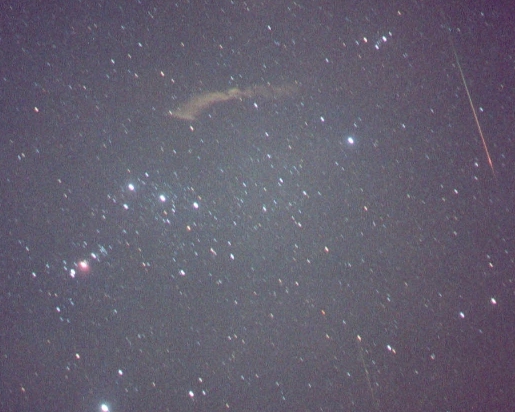
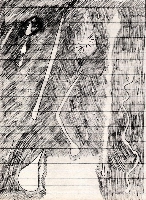 So here's another report
on the 2001 Leonids, from West Alabama. I saw the
1966 Leonids (not the West Coast version, but highly memorable
nonetheless), as a 9-year-old in Nashville - I still have a page of
sketches done then, linked in at right.
So I didn't want to risk missing any possible replay, with the added symmetry that
one of our kids was within three months of my age during the '66 shower.
So, Younger Son Nathan and I bundled off to Moundville Archaeological
Park about 20 miles away, where we take astronomy classes for
deep-sky observing. It was a bit hazy, with the Moon a distorted
and quite orange crescent setting as we arrived. Not as much Milky
Way to be seen as usual, but we were reasonably far from city lights.
To begin with, there was a Boy Scout troop doing some of their astronomy
merit badge activities, so a constellation talk plus viewing through
a 17" Dobsonian got started. Nathan insisted on organizing the lines
to the eyepiece. They got views of Mars, Jupiter, Saturn, asteroid Vesta,
and comet LINEAR (2000WM1), which gave them the whole life-cycle of
dust particles in the inner solar system when added to meteors.
We also showed bvarious visitors a bunch of deep-sky objects -
the
Crab Nebula,
Orion Nebula,
Andromeda Galaxy and its buddies,
Ring Nebula,
and a bunch of star clusters from Perseus to Gemini.
It was tough to go for the more obscure objects because the finder
scope fogged up early - had to switch eyepieces in and out of the car
to keep viewing. Fogging also figured later in the night.
So here's another report
on the 2001 Leonids, from West Alabama. I saw the
1966 Leonids (not the West Coast version, but highly memorable
nonetheless), as a 9-year-old in Nashville - I still have a page of
sketches done then, linked in at right.
So I didn't want to risk missing any possible replay, with the added symmetry that
one of our kids was within three months of my age during the '66 shower.
So, Younger Son Nathan and I bundled off to Moundville Archaeological
Park about 20 miles away, where we take astronomy classes for
deep-sky observing. It was a bit hazy, with the Moon a distorted
and quite orange crescent setting as we arrived. Not as much Milky
Way to be seen as usual, but we were reasonably far from city lights.
To begin with, there was a Boy Scout troop doing some of their astronomy
merit badge activities, so a constellation talk plus viewing through
a 17" Dobsonian got started. Nathan insisted on organizing the lines
to the eyepiece. They got views of Mars, Jupiter, Saturn, asteroid Vesta,
and comet LINEAR (2000WM1), which gave them the whole life-cycle of
dust particles in the inner solar system when added to meteors.
We also showed bvarious visitors a bunch of deep-sky objects -
the
Crab Nebula,
Orion Nebula,
Andromeda Galaxy and its buddies,
Ring Nebula,
and a bunch of star clusters from Perseus to Gemini.
It was tough to go for the more obscure objects because the finder
scope fogged up early - had to switch eyepieces in and out of the car
to keep viewing. Fogging also figured later in the night.
We made a point of not announcing a public viewing session this year, after a prior experience when the crowd was large, full of headlights, and unruly. The police almost had to clear the park after fights broke out about music from pickup trucks, and viewers in sleeping backs came close to being run over by drivers who took off cross-country. So there were only about 10 people at our location, including one visitor from Birmingham who brought a giant thermos of hot water and chocolate mix. The right thing in the right place at the right time!
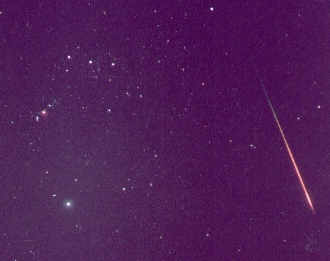 The first Leonids turned up about 2340 local time (CST), a pair of
fireballs coming up from near the horizon. From there things
just got better and better. Most of the Leonids until 0300
or so were quite bright (magnitude -1 or brighter), with fainter
ones becoming increasingly numerous after that. The Leonids
also looked faster as the night went on, which could be a geometric
effect in which ones were easiest to see as the entered the atmosphere
at different angles.
The first Leonids turned up about 2340 local time (CST), a pair of
fireballs coming up from near the horizon. From there things
just got better and better. Most of the Leonids until 0300
or so were quite bright (magnitude -1 or brighter), with fainter
ones becoming increasingly numerous after that. The Leonids
also looked faster as the night went on, which could be a geometric
effect in which ones were easiest to see as the entered the atmosphere
at different angles.
Several folks remarked on the intense short bursts - the statistical issue of whether these bursts are significant should be laid to rest by data on this shower. We'd see 5-7 meteors within a couple of seconds followed by a lull of many seconds, or 2-3 bright ones in various parts of the sky as nearly simultaneous as the eye could tell. This fits with my 1966 descriptions, including pairs and triplets which followed each other down at intervals of a few degrees. There were enough meteors to make the radiant visually obvious, especialy as the night wore on and one could see meteors in Leo itself. During the bursts, the shower was very reminiscent of the 1966 storm as seen from the eastern US (which was running about one a second, not quite like the west-coast version).
We saw many double-flash meteors, particularly one bolide about 0400 that cast shadows from both bursts (Gary Holmes , who was organized enough to bring two cameras, got a picture, which he's let me post below, while my camera field of view caught just the beginning of its streak). It left a long-lasting trail, which I was fast enough to get on film (also below). I've wondered a bit about these double flashes, and suspect it may come from materials with two flash points because of chemistry or density. At the time I thought it might be ices versus silicates in the cometary debris, but after half a dozen perihelion passages outside the insulation of a cometary nucleus, ices wouldn't be there any more.
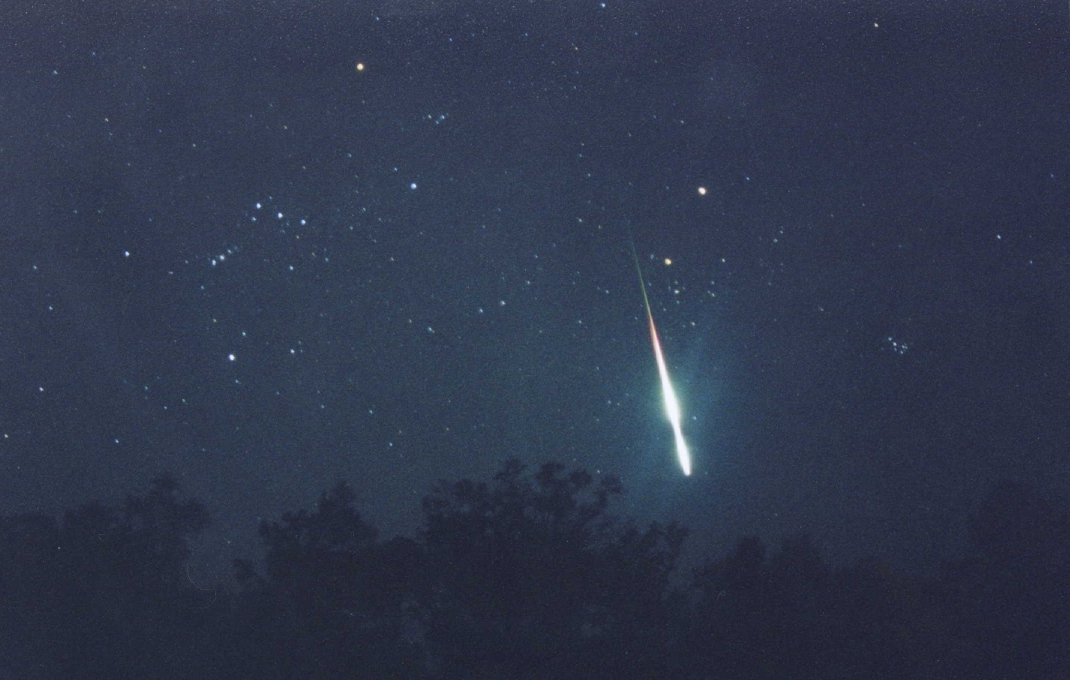 |
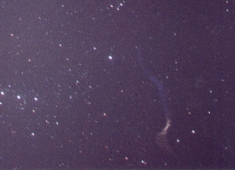 |
Four or five bolides were bright enough to light the ground and cast shadows, so you'd see them even looking the other way. One appeared as a flash in the sky from a meteor over the horizon. One really bright one about 0500 left a trail through Orion that lasted for a good 5 minutes as it twisted in the high-altitude winds. The trails appeared quite greenish visually, but are pretty red on film, which may mean there are strong emission lines out around H-alpha, where some films are very sensitive but the eye isn't when viewing at low intensity. A series of pictures of the trail also caught two meteors each on a couple of frames. Here's the series, cropped to emphasize the trail. The varying exposure times show up in the star-trail lengths. The last entry is an animated GIF of the whole set, which looks a bit jerky because of the different exposures and the fact that the prints weren't perfectly aligned when I scanned them...
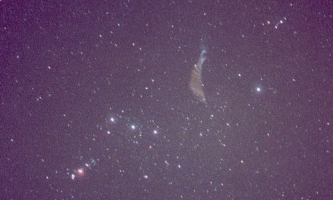 |
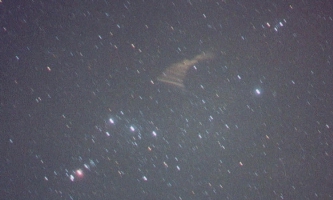 |
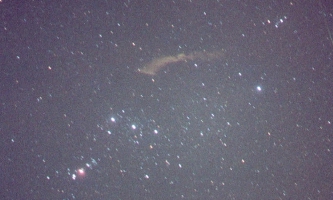 |
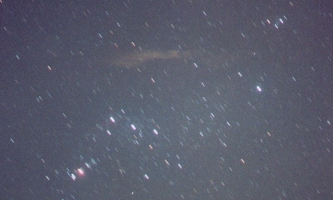 |
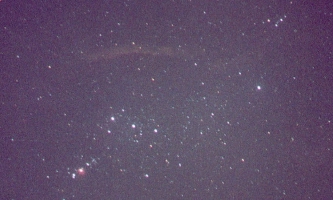 |
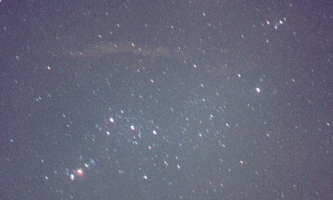 |
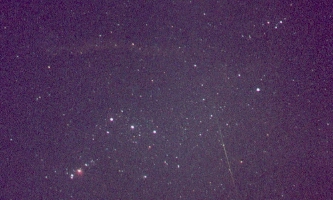 |
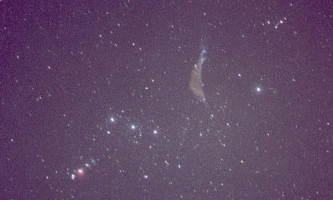 |
I shot a couple of rolls of film (Kodacolor 800 and 1000, using an Canon AT-1 with 50mm f/1.8 original lens), stopping every 10 minutes or so to put the camera in the car and evaporate the dew fogging the lens. (That's what makes carrot-shaped star trails). Of 46 pictures, 17 showed meteors. That's pretty impressive, in comparison to my previous total number of meteor trails photographed: one. The glowing trails of several meteors show up well, one of them dispersing in the high-altitude winds for 5 minutes before fading away. These trails (visually green, but photographically a bit red) were very common, staying behind almost all the bright Leonids for a few seconds.
I agree with the folks who claim you could do good meteor counts with a tape recorder and a group of people. The exclamations of "Ooh" for a typical one, "Aahh" for a brighter one, and "Aaaaaaahhh" (Doppler-shifted by pivoting necks) mark out various brightness ranges. My "Gotcha!" when one went through the camera field of view was a bit more calculated...
There were some sporadic meteors that would have been memorable in themselves on a normal night. About 0345, a pair came in on similar S-N trajectories just a couple of second apart, each about magnitude -5 and looking like magnesium flares.
From our spotty counts, each of us must have seen over 1000 Leonids. They were seen at up to 1/10 seconds by 0320 (with wide variations on timescales of a few minutes), rising to 1/7 seconds or so for me by 0445. The peak seemed to start about 0410 CST, and it kept on going for over an hour until twilight. We saw our last Leonid about 0528, as we were packing up. In the dawn we could see that extensive cirrus cloud had rolled in, but we sure couldn't tell it from watching the shower.
Last changes: June 2004